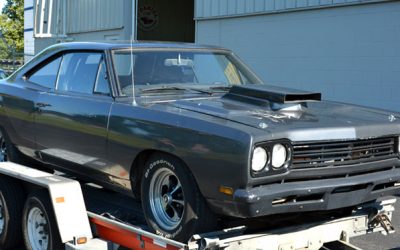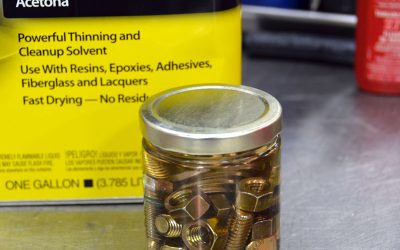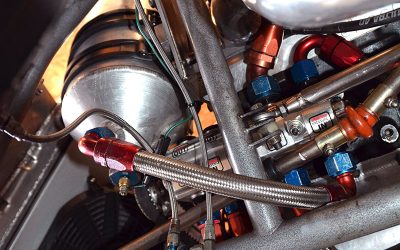Just finished up two engines and sent a good friend off for another season of Super Comp and Super Gas racing. I have to admit I don’t really get this kind of racing. It is, as another friend put it, like trying to hit the moon with a BB gun. Build a bunch of power, then shut it partially down, then back to wide-open throttle and try to hit an exact 8.900 or 9.900 with all the top speed you can muster so you can run the slow guy down from behind and catch him right at the finish line. And jump on the brakes near the finish if you think you’ll break out. Sure seems like it was more fun to just build all the power you could and go like hell and whoever got there first was the winner.
This was the first year that I really got to do nearly all of both builds and I’ve got to tell you that it is one tedious task to build engines designed to make something in excess of a thousand horsepower that can withstand what is, essentially, a full quarter mile high-gear pull, while hot (if you’re lucky or good enough to go until the rounds are running back to back) without detonating it so hard it shucks its guts. Everything in these engines is measured in “holy crap I think it’s touching†clearances. In fact, in a lot of cases we DO catch the piston with the head and the valves with the pistons. You know it’s serious when you machine the piston top to precisely match the valve angles not because you’re maximizing clearance, but because you’re counting on the valve to hit at one time or another and you want the angles to match so you don’t bend the valve. The first time my mentor told me that’s why we did it that way, I looked at him like he was growing an appendage out of his forehead. It isn’t that some things are close, it’s EVERYTHING that’s close. Pushrods almost hit intakes, rods almost hit cams and windage trays, rockers almost hit retainers (and did hit the valve covers until we ground a bit off to let them clear). The first time I watched the piston and valve race through the ports I was cringing — it looked to me like there was no way to avoid crashing parts. At these kinds of tolerances even a bit of extra rod bearing clearance turns zero piston-to-head clearance at 8,000 rpm into, “Oh, look . . . we touched!â€Â Thank goodness for good parts, good tooling, and good machine shops.
I’m not saying it isn’t fun and challenging. I’m not saying that I don’t improve my processes every time and get better and better at my documentation. I’m saying that I’ve never built a big block watch before.
I have to say that I would never have been able to do this kind of work when I was young. I was too impatient and prone to losing my temper over trivial matters. It takes a certain mindset to put something together and take it apart and put it together and take it apart over and over. Mocking things up is just part of what has to be done now, both in the race shop and in the restoration shop I work at part time.
I’d like to tell you that I see the next generation lining up to do this work, but I’m not sure that kids raised to scream at a microwave because it takes too long are ever going to have the patience for it. Maybe my attitude about this is unreasonable. I am, after all, a senior citizen now and proud of it. I never thought I’d live long enough to claim the title! I know that as one ages one’s memory fails. We were far more responsible, more dedicated, and capable than our offspring at the same relative points in life. We forget what loons we were. We become less liberal, more conservative and prone to talking about the good old days when we walked to school in three feet of snow — and it was uphill both ways.
I do miss the rumble of the big healthy V8s and I’m glad to see the next generation of Mustangs, Camaros, Mopar Hemi’s out thundering around the neighborhoods (I just wish I could afford one!). In my case, it’s not the car so much as the tickets I’d collect. I DID lose my license a couple of times when I was a youngster for speeding and speed contests, and I’m not entirely sure that behind the wheel of a car like that I would demonstrate sufficient maturity to keep out of trouble. Of course, today you can get put in jail for street racing — never done that before. Maybe it’s more fun that it appears.
A couple of us senior locals were talking about that one day. On any given night in the old days you’d hear the rev-rev-rev and screech of tires all over town, especially after about 11:00 PM. Nowadays that would draw the law like ants to a picnic. And there certainly wasn’t as much traffic in yesteryear. Street racing was, in retrospect, pretty stupid. But it sure was fun! Even if you weren’t racing it was fun just watching.
While I appreciate the high technology that powers today’s street cars, there’s no sound like big displacement and lots of cam. It’s like the music you listened to when you were in high school. It becomes the music you listen to all your life, even after you figure out that it really wasn’t all that good to start with (and we all know how much more horsepower is coming out of the factory today compared to the sixties technology we remember so fondly).
I guess the best we can hope for is that the youngsters that are out there building the next generation of racers out of the Asians, Euros, and new American muscle cars learn to love the smell of exotic fuels and oils and learn the patience to become the next generation of watch builders. One can only hope…
*Lead image courtesy Michael Theis




0 Comments